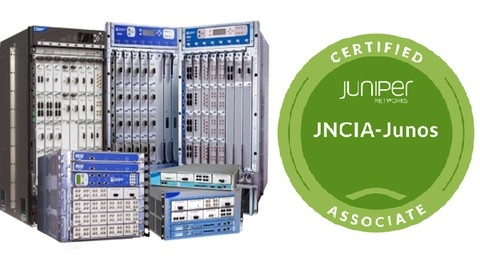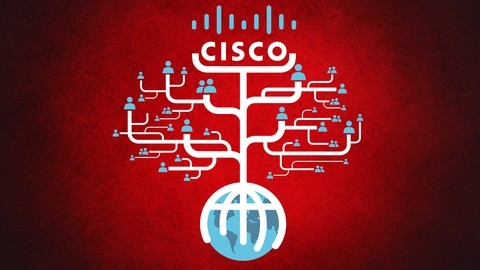OSPF, or Open Shortest Path First, is a link-state routing protocol commonly used in large and complex network environments.
It’s a powerful tool for managing traffic flow and ensuring efficient communication between network devices.
However, learning OSPF can be daunting, especially if you’re new to network routing protocols.
Finding the right course can make all the difference in your learning journey.
You want to master OSPF, but you don’t want to waste time with a course that leaves you feeling lost and confused.
That’s why we’re excited to recommend OSPF for the Real World - From Zero to Hero as the best overall OSPF course on Udemy.
This course is designed for both beginners and experienced network professionals, providing a clear and engaging learning path from foundational concepts to advanced security configurations.
It combines in-depth explanations with practical exercises and real-world scenarios, ensuring you grasp the principles and gain the hands-on skills to confidently implement OSPF in your network.
We understand that everyone has different learning preferences and needs.
If you’re looking for a specific approach or focus, we’ve compiled a list of other excellent OSPF courses on Udemy that cover diverse topics and learning styles.
Keep reading to discover the perfect OSPF course for your journey!
OSPF for the Real World - From Zero to Hero
This course provides a comprehensive exploration of OSPF, guiding you from foundational concepts to advanced security configurations.
You’ll begin by grasping the core OSPF mechanics, dissecting packet types like LSA, Hello, and DBD.
These building blocks are crucial for understanding how OSPF facilitates data routing.
The course delves into practical network scenarios, covering OSPF areas, router types, and neighbor adjacency states.
You’ll learn how to establish neighbor relationships between routers and practice configuring OSPF, a valuable skill for network troubleshooting.
The course also tackles the OSPF cost metric, demonstrating how it influences routing decisions and exploring the concept of reference bandwidth.
You’ll then dive deep into the intricacies of OSPF LSAs, the heart of the routing process.
The course carefully breaks down the different LSA types, including Type 1 and Type 2 LSAs, helping you understand their roles in network topology construction.
You’ll learn to configure various network and area types, such as stub and NSSA areas, and gain proficiency in utilizing opaque LSAs for controlled information flow.
The final module focuses on securing your OSPF domain, exploring techniques like passive interfaces and authentication.
You’ll learn how to prevent unwanted OSPF traffic and establish secure communication between routers using password-based and hash-based authentication methods.
The course goes into detail about keychains, key rotation, and hmac-sha keys, essential techniques for managing authentication keys and ensuring network security.
CCIE Enterprise Infrastructure - OSPF
This comprehensive course equips you with the skills to design, implement, and troubleshoot advanced OSPF configurations.
You’ll gain a deep understanding of OSPF fundamentals, starting with neighbor relationships and adjacencies.
The course delves into the intricacies of troubleshooting these relationships, providing you with practical skills to resolve common issues.
You’ll explore the various types of OSPF routes and LSAs, gaining a thorough understanding of their functions and interactions.
The course covers both OSPFv2 and OSPFv3, including the configuration and management of address families.
You’ll learn how to navigate different network, area, and router types within the OSPF framework.
Beyond the basics, you’ll delve into advanced topics like OSPF virtual links, path preference, and the role of administrative distance in routing decisions.
The course covers essential OSPF operations, such as default route configuration, OSPF summarization, and the use of passive interfaces.
You’ll learn how to implement graceful shutdown, ensure OSPF TTL security, and understand the importance of OSPF convergence.
You’ll also explore advanced concepts like OSPF LSA and SPF throttling, fast hellos, and effective filtering techniques using distribute and filter lists.
The course covers VRF-Lite and its integration with OSPF, enabling you to handle complex network configurations.
You’ll be equipped to master complex scenarios involving OSPF redistribution with protocols like BGP, EIGRP, and RIPv2.
The syllabus goes beyond traditional OSPF concepts, covering loop prevention strategies and route-tagging techniques for enhanced network security.
You’ll learn about various authentication methods, including clear text, MD5, and HMAC SHA authentication, as well as OSPFv3 IPSec authentication.
Finally, you’ll explore Bidirectional Forwarding Detection (BFD) and its implementation with OSPF for enhanced network reliability.
This course provides a comprehensive and practical approach to mastering OSPF, equipping you with the skills to confidently design, implement, and troubleshoot complex OSPF configurations.
Juniper JNCIA Junos JN0-105 and 7 Hours of BGP-ISIS-OSPF L2
This comprehensive course dives deep into the world of Juniper networking, providing a solid foundation in the basics and then guiding you through the complexities of routing protocols.
You’ll start by understanding the Juniper JNCIA certification, which focuses on the JN0-104 and JN0-105 exams.
This course is your key to unlocking these certifications and gaining valuable skills in today’s networking landscape.
You’ll begin by exploring core networking concepts like the OSI and TCP/IP models, MAC addresses, and IP addressing.
The course explains subnetting, supernetting, and routing concepts, including TCP vs UDP, class of service, and longest match routing.
To solidify your understanding, you’ll get hands-on experience with practical labs that simulate real-world scenarios.
Once you’ve mastered the fundamentals, you’ll dive into the Juniper OS, exploring its architecture, CLI interface, and configuration basics.
You’ll learn how to configure user accounts, interfaces, and implement security features like NTP, syslog, and SNMP.
You’ll also get an introduction to J-Web, Juniper’s web-based management interface, which provides a user-friendly way to manage your devices.
The course then covers operational monitoring and maintenance, equipping you with essential commands, tools, and procedures for managing your Juniper devices.
You’ll learn about software upgrades, troubleshooting techniques, and even password recovery, ensuring you can handle any situation that arises.
But the real highlight of this course comes in the “Extra Content” sections, where you’ll delve into key routing protocols like RIP, OSPF, ISIS, and BGP.
You’ll learn how to configure each protocol, understand their functionalities, and discover their unique features.
The course dives into single and multi-area configurations, authentication, and BFD for each protocol, giving you a comprehensive understanding of these essential routing technologies.
You’ll be well-prepared to tackle the JN0-105 exam and confidently manage Juniper devices in real-world scenarios, giving you a competitive edge in the networking field.
Cisco OSPF Breakdown!
This comprehensive course provides a solid foundation in OSPF, guiding you from the fundamentals to advanced configurations.
You’ll begin by diving into essential OSPF terminology, learning about concepts like neighbor adjacency, LSA flooding, and the shortest path calculations that lie at the heart of OSPF’s routing decisions.
You’ll gain a deep understanding of how OSPF uses different types of LSAs to share network information, enabling efficient and reliable routing.
The course also thoroughly explores how OSPF determines the best path for traffic, delving into the metrics used for this critical decision-making process.
Practical application takes center stage with hands-on exercises using Packet Tracer, allowing you to configure various OSPF network types, including point-to-point and multi-access networks.
You’ll learn to navigate advanced configurations, mastering commands like “passive interface” and “default-information originate” to fine-tune your OSPF deployments.
Mastering OSPF goes beyond configuration.
You’ll develop essential troubleshooting skills by analyzing the output of key commands, including “show ip ospf”, “show ip ospf database”, and “show ip ospf neighbor”.
This deep dive into command analysis will give you the confidence to diagnose and resolve real-world OSPF issues.
The course doesn’t shy away from the complexities of multi-area OSPF, guiding you through the intricacies of configuring and managing these more advanced networks.
You’ll even explore the world of OSPFV3, the IPv6 version of OSPF, ensuring you’re equipped to handle the challenges of future network deployments.
By the time you complete this course, you’ll possess a strong understanding of OSPF’s inner workings, enabling you to configure and troubleshoot OSPF networks with confidence in any real-world scenario.
Cisco OSPF Practical Labs 2023- Basic to Advanced
This comprehensive OSPF course provides a strong foundation in both the fundamental and advanced aspects of this critical routing protocol.
You’ll start by mastering the basics of OSPF configuration, building a solid understanding of concepts like inter-area routing, MTU values, and Designated Router election.
The course doesn’t just teach you theory.
You’ll get hands-on experience with OSPF through practical labs and exercises.
Learn how to debug OSPF issues, calculate metrics, and configure passive interfaces, essential skills for any network administrator.
Moving beyond the basics, you’ll explore advanced topics like redistribution, allowing you to combine OSPF with other routing protocols like EIGRP.
You’ll also delve into the critical topic of authentication, ensuring the security of your network.
The course doesn’t shy away from crucial concepts like STUB areas, NSSA, and Totally Stubby areas, providing you with a comprehensive understanding of OSPF.
Finally, the course concludes with a valuable section dedicated to OSPF interview questions, covering a wide range of topics from basic configurations to complex scenarios.
This section will help you solidify your knowledge and confidently tackle any OSPF-related interview questions.
This course is a solid choice for anyone seeking a thorough understanding of OSPF, whether you’re a beginner or looking to enhance your existing knowledge.
Cisco OSPF - Complete Understanding | Hands-on Training
This course provides a comprehensive and practical approach to mastering OSPF routing.
You’ll start by getting a firm grasp of OSPF fundamentals, including essential terminology like areas, routers, and neighbors.
The course then delves into the complexity of OSPF routing, breaking it down into manageable concepts.
You’ll learn about the various OSPF tables, which essentially act as maps for your network, and the crucial role of Designated Routers (DRs) and Backup Designated Routers (BDRs) in efficient traffic management.
The course then transitions into hands-on exercises, guiding you through building both single-area and multi-area OSPF networks.
This practical approach allows you to learn how to configure OSPF for different network layouts, including multi-area network configurations, summarization techniques, and implementing passive interfaces for enhanced security.
The course also covers OSPF authentication, a vital step in protecting your network from unauthorized access.
By combining theoretical knowledge with practical application, this course empowers you to confidently implement and troubleshoot OSPF networks in real-world scenarios.
OSPF on MikroTik with LABS (RouterOS v7)
This course offers a comprehensive exploration of OSPF on MikroTik RouterOS v7, diving deep into both the foundational principles and advanced configurations.
You’ll start by grasping the core concepts of routing protocols, including the distinction between EGP and IGP, and the workings of link-state protocols.
You’ll then delve into the intricacies of OSPF, unraveling the mechanisms behind LSAs, LSDB, and the SPF Algorithm.
Hands-on labs will provide practical experience in configuring basic OSPF and manipulating Hello packets, a crucial aspect of establishing OSPF neighbor relationships.
You’ll also master the intricacies of DR and BDR elections, navigating through practical scenarios to reinforce your understanding.
The course extends to multi-area configurations, guiding you through the setup of internal routers, ABRs, and ASBRs to manage complex networks effectively.
You’ll learn to optimize your networks with network aggregation (summarization) and control routing updates through the passive interface.
Advanced topics, such as Stub areas, are tackled with hands-on practice, allowing you to configure various Stub area types, including Totally Stub and Totally NSSA.
The course concludes by tackling the complexities of virtual links and their configuration.
You’ll also gain knowledge of Layer 3 hardware offloading and Bidirectional Forwarding Detection (BFD), crucial techniques for enhancing network performance and reliability.
Cisco EIGRP and OSPF Training
This comprehensive course equips you with the knowledge and skills to master two essential dynamic routing protocols: EIGRP and OSPF.
As a network administrator, understanding these protocols is critical for connecting networks, sharing information seamlessly, and troubleshooting common issues.
You’ll begin by diving deep into EIGRP, starting with the fundamentals of configuration and neighbor relationship establishment.
The course breaks down the different packet types used by EIGRP and walks you through the intricate process of metric calculation, crucial for determining the most efficient data path.
You’ll gain proficiency in advanced EIGRP concepts such as manual and auto summarization, which simplify network complexity.
The course also equips you with the ability to effectively load balance traffic across multiple paths, optimizing network performance.
You’ll learn to identify and resolve common EIGRP issues, ensuring smooth network operation.
Following your mastery of EIGRP, you’ll delve into OSPF, another vital routing protocol.
You’ll uncover how OSPF manages its routing tables, prioritizing paths based on specific metrics.
The course comprehensively explores the various types of areas used in OSPF, including stub areas, and introduces the concept of the virtual link.
You’ll also learn about OSPF’s authentication capabilities, which enhance network security.
The course concludes with essential troubleshooting skills for OSPF.
You’ll master the art of utilizing show commands to pinpoint and resolve common OSPF issues, becoming a confident network professional capable of efficiently managing and maintaining your networks.
By completing this course, you’ll gain a thorough understanding of both EIGRP and OSPF, making you a valuable asset to any IT team.
You’ll be equipped to design, implement, and troubleshoot robust routing solutions, ensuring your network operates efficiently and securely.
Dynamic Routing Protocols Mastery: Guide to RIP, EIGRP, OSPF
You’ll start by building a foundation in RIP (Routing Information Protocol), exploring its basic operations, configuration, and limitations.
The course then delves into RIPv2, highlighting its improvements over its predecessor.
Next, you’ll move on to EIGRP (Enhanced Interior Gateway Routing Protocol), a more advanced protocol that offers improved performance and efficiency.
You’ll learn how to configure EIGRP, understand its unique features, and develop troubleshooting skills for common issues.
The course concludes with an in-depth exploration of OSPF (Open Shortest Path First), a widely used dynamic routing protocol.
You’ll dive into OSPF’s architecture, including its neighbor discovery mechanisms and data packet management.
The curriculum also covers essential configuration elements, such as router IDs, authentication, and the various OSPF area types.
Throughout the course, you’ll benefit from hands-on labs and real-world case studies.
These practical exercises allow you to apply your newfound knowledge and develop essential troubleshooting skills.
You’ll gain a solid understanding of concepts like route summarization and network types, preparing you for real-world network management challenges.
You’ll be confident in your ability to effectively manage and troubleshoot these protocols within your IT environment.
This knowledge will empower you to optimize network performance, improve reliability, and enhance the overall efficiency of your network infrastructure.
Cisco Networking CCNA OSPF
You’ll learn the fundamental concepts of OSPF, starting with the basics of enabling the routing process and understanding the significance of the Router ID.
You’ll gain practical experience in setting the OSPF cost using Reference Bandwidth, and learn how to optimize network performance with OSPF Fast Hellos.
The course delves into different OSPF Network Types, equipping you to select the most appropriate configuration for your network.
You’ll also gain a deep understanding of OSPF security with MD5 authentication, both at the interface and process ID levels, ensuring your network is protected from unauthorized access.
The course goes beyond the basics, exploring advanced OSPF concepts like Stub Areas.
You’ll discover how Stub Areas can simplify your network by reducing routing overhead and learn how NSSA (Not So Stubby Area) interacts with them.
You’ll gain a practical understanding of Route Redistribution and Summarization, crucial techniques for managing routing tables in complex networks.
The course concludes with advanced configurations, including generating a default route, configuring DNS name lookup, and suppressing hello packets.
These configurations allow you to optimize your OSPF implementation for specific network needs.
While the course effectively covers a wide range of OSPF concepts, it could benefit from more in-depth explanations of certain advanced topics like Virtual Links, and potentially include more practical exercises to reinforce learning.










